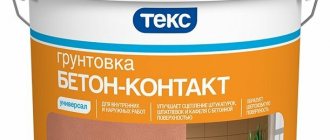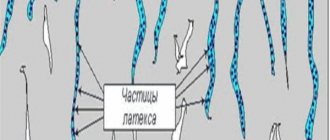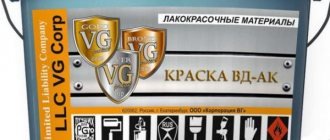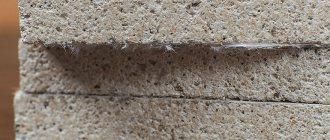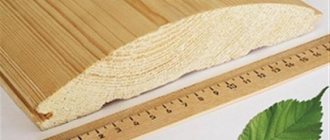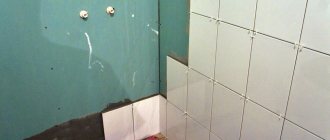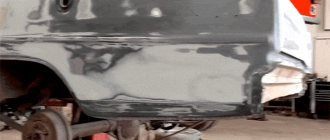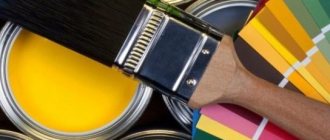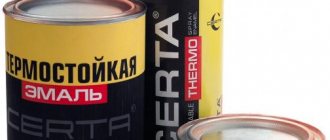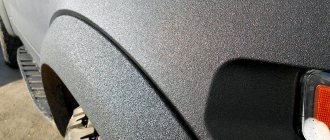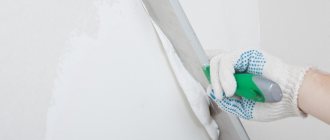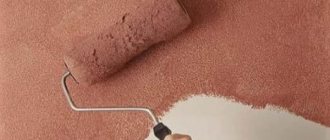The modern building materials market is constantly updated with new compounds. They have improved characteristics. This allows construction and repair work to be carried out faster. The end result using innovative technologies is of high quality. One of the important means used for finishing work is an adhesive primer.
The category of products presented included several different formulations. To choose the appropriate option for construction and repair work, it is necessary to consider the technical characteristics and features of each type of primer.
general characteristics
Starting renovations in an apartment is associated with a lot of questions. Many private property owners do not know what material for finishing work will be required in a particular case. Therefore, the advice of experienced repairmen will help in resolving this issue.
Adhesion is the ability of the substrate to firmly adhere to the finish. In this case, the layer applied to the surface does not peel off. It will remain on the base for a long time. Some materials need increased adhesion levels. In this case, a special primer is used.
There are many similar formulations on the market. They are capable of enhancing surface adhesion to a greater or lesser extent. When choosing, it is important to consider what characteristics the base has. There are rough and smooth materials. When processing them, the primer must have not only adhesive properties. A number of additional effects are present in such formulations.
Main types of soils
Thanks to the correct selection of primer, taking into account the characteristics of the surface being treated and the finishing material, the finish will be attractive, high-quality and durable. Before plastering the walls, tiling them, gluing wallpaper, laying linoleum or laminate, the base must be primed with a suitable type of primer. In stores today there is a large assortment of these mixtures, and a simple consumer may ask a pertinent question, which mixture is better to choose? Modern primers are divided into several groups, according to their purpose:
- adhesive - allow the base to firmly and reliably adhere to the finishing material, so the repair work will be durable, the finishing will not peel off or fall off. Basically any type of primer is adhesive;
- Fixing primers are used for fragile and loose surfaces that crumble easily. After priming such bases, they become durable, since the composition penetrates deeply into the material, reliably holding all its particles together;
- insulating primers are necessary to prevent the release of any elements from the surface, for example, resinous liquid from wood. Such primers form a moisture-proof layer that isolates the base from the finishing material;
- anti-corrosion primers are used to reliably protect metal surfaces from the harmful effects of the environment; thanks to the protective film, the metal does not rust and corrosion does not appear on it.
Primers can be regular or deeply penetrating; they can be divided according to their composition. There are alkyd, acrylic, polyurethane, glyphthalic, mineral and latex mixtures. Each primer can be used to treat a specific material, for example, concrete (concrete contact), plaster, metals, wood. In addition, there are primers only for indoor or outdoor use, and some compounds (universal) can be used both outdoors and indoors. Primers are also divided according to properties; the mixture can be anti-corrosion, moisture-resistant, fire-resistant, antiseptic, antifungal.
Acrylic adhesive primers are universal compounds, which is why they are the most popular nowadays. Acrylic primers can be used for treating wood, concrete, metals, brick, plaster and putty. These primers act as fixing, adhesive and insulating compounds. When applied to metal surfaces, they create a thin, durable, protective layer against rust and corrosion.
Depending on the nature of the impact, there can be different adhesive mixtures:
- solutions that are distributed in an even layer on the base; after drying, they form a surface film;
- impregnations, for example, acrylic primers, which penetrate deeply into the material, affecting its entire volume; such impregnations can reach a depth of 10 centimeters, especially if a porous, loose base is processed.
Solvent-soluble adhesive primers are used during the treatment of building facades. These primers are resistant to contamination, proliferation and penetration of various microorganisms, as well as the harmful effects of precipitation and temperature fluctuations.
Water-soluble primers are breathable, environmentally friendly and safe for humans, so they are usually used for priming indoors.
Rough surfaces
The properties of an adhesive primer can vary significantly depending on the type of composition. All surfaces on which the presented materials are applied are conventionally divided into two groups. These are rough and smooth bases. When choosing a primer, it is important to consider the type of surface it will be applied to.
All adhesive primers that are used for rough substrates differ in a number of characteristics. They have high penetrating ability. Even dusty surfaces are properly glued and strengthened. In this case, the initial characteristics of the base are noticeably improved.
The pores of the surfaces are closed. The consumption of finishing materials in this case is significantly reduced. Paint, glue, plaster are absorbed evenly. If it contains special components, the primer can prevent the development of fungus and mold on surfaces.
Purpose and application
The term “adhesive primer” refers to soils that contain quartz sand and polymers. Sand imparts a certain degree of roughness to the entire mass so that construction mixtures in the form of putty and plaster (their base can be different: cement, acrylic, gypsum) adhere well to other finishing materials.
Main functions of the solution:
- protects metal from corrosion;
- does not allow moisture to penetrate building materials;
- protects against fungal infections and mold;
- increases the strength of cracked and porous surfaces.
IMPORTANT. You can often find another name in stores: “concrete contact”, which has high alkalinity.
Smooth surfaces
Please note that a primer for concrete may differ significantly from a similar product for plastic. There is a large list of surfaces that do not have pores and are not highly absorbent. The primer presented above is not suitable for them.
Smooth surfaces include plastic, glass, metal, paint and other similar materials. It is for them that compositions called primers are used. They are characterized by high adhesive ability. Such compositions make the surface rough. In this case, the finish can be firmly fixed to the base.
One of the most popular materials used in this case is “Betonkontakt”. It is manufactured by many large companies. The composition of such primers differs significantly from products intended for rough surfaces.
Self-cooking
- Is it possible to prepare an analogue of an adhesive primer yourself??
The price of Betokontakt is more than 3,000 rubles for a 20-kilogram package, which does not fit well into the modest budget of a small repair, so the question is quite reasonable.
The easiest way to obtain soil is to mix sodium or potassium liquid glass with sifted sand. The mixture is prepared in small portions (no more than 1 liter) and applied to the base with a brush, which is thoroughly washed with water immediately after use.
The photo shows liquid glass, also known as silicate glue.
Compound
To understand how an adhesive primer differs from a concrete contact primer and what material to purchase for various surfaces, it is necessary to consider their composition. The presented products are made on the basis of polymers. Quartz sand of a certain fraction is added to them. The smaller it is, the thinner the layer of hardened primer film on the surface will be.
Compositions intended for smooth surfaces are characterized by the presence of a larger number of adhesive components. If the sand fraction is larger, the surface will be rougher. Therefore, it is important to consider what type of finish will be used subsequently.
In addition to the components listed above, the primer may contain additional components. They will give the composition water-repellent, antibacterial, and anti-corrosion qualities. It should be noted that, regardless of the variety, all soils are vapor permeable. This is a positive characteristic of the material.
Purpose
The beginning of renovation in the apartment is accompanied by the purchase of necessary materials. You should find out in advance in which cases you cannot do without a primer. First of all, it is used for cladding. Before installing tiles, laminate, self-leveling floors or linoleum, a primer is used.
The presented composition must be applied to the surface before painting. This significantly extends the life of the finish. For latex, acrylic, water-based, oil-based and other types of paints, a specific composition is selected.
Another area of application for primer is plaster. Application of starting and finishing compositions is impossible without an adhesive agent. This becomes especially important when the plaster layer is at least 3 cm thick. In this case, the finish does not slip or collapse.
Peculiarities
The primer is the link between the surface and the final finish. In order for this finish to adhere firmly to any surface (smooth, rough), it is necessary to apply a layer of thick mortar.
To easily apply putty, distribute paint evenly, and prevent moisture permeability from the inside, you cannot do without an adhesive agent.
Acrylic primer is popular today because it can be simply diluted with water.
Mineral soil allows you to apply a layer and reduce the roughness of brick, concrete, foam concrete structures.
Alkyd and glypthal mortar are needed for processing wooden products.
If you observe the following picture: the wallpaper is sagging, the decorative plaster is stained and cracked, the materials have peeled off, then this means that illiterate repairs were done without a soil foundation at all.
Primer action
Primer compositions can be divided into two groups. The first category includes reinforcing materials. The second group included a penetrating adhesive primer.
Strengthening compounds are characterized by a significant increase in the adhesion of the finish to the base. There is much more dispersion filler in this primer. This allows for maximum adhesion on smooth surfaces. If it is necessary to create a finishing layer on a smooth material that does not have pores, strengthening compounds are used. They increase the strength of the surface on which they are applied.
Deep penetration primers are used for porous materials. They contain a much smaller amount of dispersed particles. Such compositions penetrate into surfaces to a depth of 10 cm. Their adhesive characteristics will be significantly less.
Application rules
If the mixture, for example, otex adhesive primer, is in the form of a concentrated product, then it must first be diluted with a solvent. Water-based compositions are diluted with plain water. Adhesive primers of different types having different bases should not be mixed with each other.
Before the penetrating adhesive primer is applied to the surface, the base must first be prepared. The surface is cleaned of dust, dirt, grease stains, and crumbling finishing materials; if necessary, the surface must be washed and dried.
A primer, for example, otex or some other adhesive mixture, is applied to a clean, dry base. The application process is carried out with a brush, roller or high-pressure spraying from a spray gun or spray gun. Upon completion of work, all tools used for priming should be washed with solvent or plain water.
Experts recommend applying adhesive primers in two layers; after applying the first layer, you need to take a break so that the composition has time to dry completely. When first applying, you can use a regular, inexpensive mixture that penetrates deeply into the surface. It will strengthen the base and create a waterproof layer. After this, you can apply a more expensive layer of soil, for example concrete contact, the consumption of which will be significantly reduced thanks to the first layer. Priming cannot be neglected; this procedure reliably protects the surface and also significantly increases the adhesion rate of the base to the finish.
Compound
There are several types of adhesive primers that differ in composition. There are 4 main categories of funds. The first group includes acrylic adhesive primer. These are environmentally friendly compounds. They do not emit a pungent odor. This is the most versatile type of soil.
Alkyd varieties are used for internal processing. They are made from organic solvents. Such compositions have a pungent odor. For use on non-absorbent surfaces.
Glypthal primers are applied to metal and wooden surfaces. They take a long time to dry. Also, these compounds should be used only for dry rooms.
Perchlorovinyl primers are used for a wide range of surfaces. This is a toxic composition. It is used exclusively for outdoor work. The soil dries out quickly. After an hour, you can begin the subsequent finishing.
Differences in primer by type of composition
In order to properly treat the area where the adhesive primer will be applied, you need to know what materials are needed for the work and what protective primer to choose. Today there are several options in stores:
- Alkyd. Thanks to the organic solvents that are part of the mixture, the solution fits well on any surface.
- Perchlorovinyl. Can be used in premises of any purpose. It is important to take into account the fact that the substances that are included in the composition are extremely dangerous to human life and health, so it is best to use the solution for outdoor work.
- Acrylic. It does not emit an unpleasant odor, the chemical composition is absolutely safe, therefore it is used for both internal and external finishing works. Hardens quickly and applies evenly. The composition contains the following components: acrylic resins and additional additives.
- Glyphthalic. Enhances the color of paints and varnishes thanks to the coloring pigments that are part of the mixture. Antiseptic and anti-corrosion properties protect objects to which the primer is applied. Wood, metal, and brick coatings can be processed.
"Betonkontakt"
When choosing a primer for concrete and other smooth surfaces, you should give preference to a variety such as “Betonkontakt”. The product presented was first produced in Germany. It was first introduced to the market. Subsequently, other world brands began to produce the presented composition.
This is a universal product that can significantly improve the adhesion of the finish to the surface. It is used not only for concrete, but also glass, metal, tiles and even painted surfaces.
If the base has a low ability to absorb moisture, preference should be given to “Betonkontakt”. Today, in addition to Knauf primers, compositions and Prospectors are very popular of this type. Their prices vary significantly. It can range, depending on the manufacturer, from 200 to 500 rubles. for 1 l.
Types of primers
When choosing a primer composition, you should evaluate the following factors:
- area where work is carried out: outdoors or indoors;
- conditions under which processing occurs: temperature, humidity;
- loads that concrete surfaces will have to withstand;
- possible effects on concrete of various environments during operation: moisture, ultraviolet radiation, chemicals, temperature changes;
- type of concrete surface (for example, a primer for foam concrete or aerated concrete should be suitable specifically for porous surfaces);
- Often the drying time of primer compositions is quite important, so when choosing a coating you should ask how long it takes for the primer to dry on concrete;
- the type of finishing material used after priming, since the compositions must be compatible.
Let's figure out which priming agents for concrete foundations should be used in various situations.
- Depending on the location of the object whose concrete surface needs to be treated, there are primers for internal and external work.
- Based on the type of surface to which the primer is applied, compositions can be used for fresh and old bases, for smooth concrete or for cellular materials. Fillers are additionally introduced into the latter to fill the pores.
Depending on the effect on the concrete surface, the compositions are divided into:
- Soaking soils. Such materials are applied to fairly loose surfaces. They are used to strengthen the top layer. The adhesive components of primers, penetrating into concrete to a depth of 50 mm and hardening, help fill microcracks and pores and bind particles together, as a result of which the concrete surface is given the necessary strength.
Impregnating primer for concrete Nova
Primer "Nova" for impregnation of porous, fragile concrete surfaces, which contains acrylic resins, silicone emulsion, biocides, suitable for external and internal work. It forms a matte film on the concrete surface that is resistant to atmospheric influences (except ultraviolet radiation).
Apply at temperatures exceeding +5 degrees in 1-2 layers with a brush, roller or spray with an average composition consumption per layer of 0.15 kg/sq.m. The price of a 5 kg canister is 700 rubles.
- Deep penetrating soils. These compounds are used to treat strong concrete surfaces. A deep penetration primer for concrete is capable of penetrating into the base structure to a depth of 5-7 mm. As a rule, penetrating primer for concrete contains latex, which allows you to create a continuous protective coating.
Deep penetration primer for concrete
The use of penetrating primer "Toiler", made on the basis of acrylic dispersion, allows to reduce water absorption of concrete and improve adhesion to finishing materials. The average consumption of the composition is 0.15 l/sq.m. It is recommended to apply this deep penetration primer for concrete in 1 or 2 layers. The cost of a 10 liter canister is 380 rubles.
- Adhesive soils. With the help of these products containing adhesion-enhancing particles, it is possible to create a film on a poorly absorbent concrete surface that has excellent adhesion to finishing coatings. This primer is very good, for example, if you plan to lay concrete on concrete over a primer.
An example of such a composition is the Eunice Concrete Active soil. It is suitable for application to smooth, low-absorbent concrete surfaces indoors and outdoors. It contains a mineral filler that improves the adhesion of the base and applied finishing coatings (wallpaper paste, plaster, tile adhesive), as well as antiseptics that protect concrete from the appearance of mold and mildew.
Work on applying this quick-drying (drying time does not exceed 4 hours) composition should be carried out at a temperature of +5...+30 degrees. The average primer consumption for concrete is 0.3 l/sq.m. The cost of a 10 liter can is around 600 rubles.
Primer Eunice concrete active
Based on their chemical composition, the following types of primers are distinguished:
- Acrylic primer
Requirements for compositions are formulated in GOST R 52020-2003 “Water-dispersion paint and varnish materials”.
The quick-drying (within 2-3 hours) water-based composition has excellent penetrating ability. Acrylic primer does not smell, and therefore it can be safely used for finishing work indoors. Such primers provide excellent adhesion to finishing coatings. From an economic point of view, these primers are the most optimal.
Important! Acrylic-based primer is not recommended for use in rooms with high humidity.
There are many acrylic-based compositions produced: primer Betonit VD-AK-020, primer “Beton-Kontakt” from, “Akrial-Grunt”, produced or composition “ST-19”, produced by the Henkel concern.
Acrylic primer Ceresit ST-19
Primers for concrete ST-19 are used for treating smooth surfaces indoors. They are environmentally friendly, vapor permeable, and contain crushed quartz sand, which helps ensure good adhesion to concrete. The soil dries in 4 hours, its consumption is 0.3...0.7 ml/m2. A package weighing 15 kg costs 1000 rubles.
- Polyurethane composition
Polyurethane primers fill small cracks and pores in concrete, provide high-quality adhesion of finishing coatings and the base, remove dust well and increase the wear resistance of the surface. The characteristics of the soils make it possible to use them for treating industrial floors.
Polyurethane primer "Polybetol"
“Polybetol” is a one-component composition, odorless, since it contains no solvents, is resistant to chemicals, and can be used as an independent coating. Consumption per 1 m2 is 0.1 kg.
The primer is applied at temperatures exceeding -10 degrees. The disadvantage of these compounds is the high price. A jar weighing 10 kg will cost 4,000 rubles.
- Epoxy primer
Epoxy primers perfectly protect concrete from moisture and chemicals. They can be applied to damp surfaces. They tolerate mechanical stress very well. Primers can be used as stand-alone coatings or under epoxy paints.
Note: It is especially worth noting the use of such compositions as a base for self-leveling epoxy floors. The only “but” is an unpleasant smell, which must be taken into account when choosing a composition.
Two-component primer for concrete "Epoxol"
“Epoxol” is an environmentally friendly coating that perfectly fights concrete dust, strengthens the surface, increases resistance to cracking and frost, and protects it from corrosion and chemical influences. The composition can be applied to wet concrete.
The primer is produced in the form of a two-component composition, the components of which are mixed and diluted with water. It is applied to a clean surface at an air temperature exceeding +8 degrees, its consumption is 200 g/m2. 7 kg of primer will cost approximately 2300 rubles.
- Alkyd primer
Alkyd primer is resistant to abrasion, penetrates deeply into the structure of concrete, is durable, and can be applied at sub-zero temperatures. However, it dries for at least 12 hours and its durability is lower than that of its analogues.
Alkyd primer for concrete “Lakra”
The red-brown Lakra composition is suitable for work indoors and outdoors. It has good anti-corrosion properties and ensures excellent adhesion of materials. Average material consumption: 0.1 kg/sq.m. It is applied in 1 or 2 layers. Drying time is 24 hours. A can weighing 20 kg costs about 2,000 rubles.
- Polystyrene primer
Polystyrene primers dry quickly, but have an unpleasant odor, so they should be applied outdoors or in well-ventilated areas. It is recommended to use such toxic compounds in production or for treating facades. They are practically not used for application to surfaces in residential premises.
- Polyvinyl acetate primer
Such compositions are used for subsequent application of PVA-based paint or glue. They are used only for indoor surface treatment. Polyvinyl acetate primers dry instantly, within an hour.
PVA primer for concrete walls
In addition to the commercially available compositions, you can also prepare a primer from PVA glue with your own hands. This adhesive is an emulsion of polyvinyl acetate, a solid, colorless and odorless substance. To prepare the primer you will need a construction type of glue.
PVA construction adhesive
The technology for making soil is simple:
- The breeding process should be carried out in a warm room.
- Glue is poured into the prepared container.
- Dilute it with water in a ratio of 1:2.
- The mixture is vigorously stirred until smooth. Care must be taken not to form a watery film.
Important! To obtain a better mixture, you should use a construction mixer.
- To improve the properties of the glue, crushed chalk is added.
Crushed chalk
As you can see, preparing a primer is not at all difficult.
However, the properties possessed by the resulting composition cannot fully ensure the performance of the functions required of the primer. Produced in artisanal conditions, the soil can only provide adhesion of materials and some protection of concrete from the external environment. In addition, using homemade primer can lead to peeling of the finish coating and the appearance of yellow spots on it (most often on wallpaper).
The prepared solution cannot fully replace factory primers. This composition can only be used for treating non-critical surfaces. So it is worth recognizing that the main advantage of this soil is its cost-effectiveness.
The option of making a primer for treating a concrete surface from wallpaper glue seems much more acceptable. To prepare a primer from such a product, you should dilute it with more water than is used to prepare the glue itself (usually the proportions are indicated on the packaging).
Glue consumption for preparing primer
Another type of primer can be made independently from acrylic paint, diluting it with water in a 1:1 ratio. The composition is suitable for application to a concrete surface before painting with the same paint.
Priming concrete surfaces can also be done using concentrates (pictured) diluted with water. This option also saves money.
Concentrated primer
For the protective treatment of concrete structures located on the street (foundations, plinths, walls, swimming pools, blind areas), waterproofing coatings are usually used. These include, in particular, liquid glass and liquid rubber. These coatings create a water-repellent layer for concrete.
Liquid rubber for concrete
Using liquid glass allows you to do without a primer, whereas when using rubber, the surface is still primed.
Liquid glass
In order to save money, you can use primer paint, which combines paint and primer components, to apply to a concrete surface.
Primer paint
Acrylic primer
If you plan to create an adhesive layer for an absorbent surface, deep penetration primers are used. They are made on a water basis. These are environmentally friendly acrylic compounds. The most famous and high-quality adhesive primers in this area are “Knauf” and “Ceresit”.
The presented compositions are used to treat not only porous concrete, but also plaster before subsequent finishing, sheets of drywall and other similar surfaces. In some cases, it will be necessary to apply several layers of the product. If you plan to process wood, the primer should include an antiseptic and pigments that mask resin stains.
Acrylic primer can be used in any room. It is highly environmentally friendly. Due to the absence of a pungent odor, this variety can even be used when decorating a bedroom or children's room.
Compatible Surfaces
Before priming, it is necessary to take into account all the nuances of surface coating. Since each of them has its own characteristics and properties. This is necessary for maximum effect after applying one or another mixture to an object. Features and influences are presented below.
Adhesive primer for concrete
Another name is concrete contact adhesive primer. Examples: Polyurethane and epoxy mortars.
Peculiarities:
- this mixture enhances adhesive strength due to its high permeability and is capable of gluing even construction dust;
- reduces the cost of paint and other coatings;
- the coloring pigments included in the composition help to separate the already coated surface from the not yet primed one;
- can be used for any purpose due to its water base;
- Drying time is several hours
- When applying, you can use either a spray bottle or a roller with brushes.
How does it work? The primer solution completely fills all flaws (including microcracks), forming a rough protective film when hardened, which not only adheres, but also protects the finishing material from moisture. To improve the effect of this primer, it is recommended to apply a second coat of the mixture.
Adhesive primer for metal
Examples: glyphthalic and alkyd mixtures. The main objective is maximum adhesion between materials with a smooth surface that has a minimum degree of moisture absorption.
It is used when it is necessary to prime a previously painted area.
Features: the composition contains those components that are responsible for preventing the occurrence of corrosion and the development of fungi. Some are able to stop rust, which is beneficial for iron floors (or other items) in large industries.
The action is very simple: after application, the solution roughens the surface, adheres and prevents cracks.
Adhesive primer for glass
A siloxane penetrating adhesive primer is a suitable option for this surface.
This material is non-toxic, water-based, without a specific odor. After application, a smooth white film appears, tightly adhering to the glass (and any glossy surfaces). Complete drying time is up to 12 hours.
Adhesive primer for wood
Examples: polyurethane primers (an expensive option, more often used for parquet floors), polyvinyl acetate mixtures (advantage in drying - 30-60 minutes), shellac compounds (used more often to block the access of resin from wood), drying oil (contains an oil composition).
Wood is widely used nowadays because of its naturalness. But various items made from it are most often exposed to bad environmental influences. Humidity, mildew, mold and many other pests can cause damage.
Treating this material with primer makes it possible to protect the wood, extend its service life and maintain its original appearance. The composition contains special resins that hold the fibers together.
Features of application:
- strengthens the wood surface. Old products especially need this;
- disinfection of material. Many trees are susceptible to rotting, so the presence of an antiseptic in the soil protects them from moisture;
- after treating the surface, its pores are closed and you can safely proceed to subsequent painting, which will lay down in an even layer without being absorbed into the wood;
- stains do not appear in the future (if the primer is chosen with good quality and composition);
- there is no need to remove the old paint from the wood, but simply cover it with a new color.
Before use and selection, you must consider the conditions and some recommendations:
- the location of the primer (internal external), since with high humidity it is necessary to contain hydrophobic elements in the composition;
- with subsequent painting, the drying time and the number of layers are taken into account (the more, the longer);
- depending on the further coating, be it paint/varnish or other enamel
For varnish, a transparent primer is used, before applying which it is recommended to remove all fibers and make the surface as smooth as possible.
Adhesive primer for tiles
Mostly quartz soil is used - concrete contact for non-absorbent surfaces.
The advantage is minimal time and labor costs in general.
It is important to cover all seams and joints of the floor (walls) with the material, before which dust and dirt must be thoroughly removed for maximum effect and protection.
Adhesive primer for plastic
For this material, one-component (aerosol) and two-component (applied with a gun) mixtures are suitable.
The composition is suitable for both acrylic and alkyd adhesive primers prepared on a water basis. For the most even effect, a plasticizer is added.
This type is characterized by rapid drying and adhesion to any type of plastic, necessary for subsequent painting.
This type of primer should be applied at a distance of 20 cm in 3-4 layers. It is recommended to carry out finishing wearing safety glasses, a respirator and away from open flames, as the mixture is toxic and flammable.
Alkyd primer
One of the popular primers are alkyd compounds. This variety is used in the process of applying paint to prepared surfaces. It is also used when old paint has already been applied to the base. The product is characterized by rapid drying.
Otex adhesive primer is in great demand in this category. It is produced by the world famous company Tikkurila. This primer is used before painting surfaces made of galvanized steel, aluminum, as well as plastic, fiberglass and ceramic tiles.
The presented composition is characterized by a matte structure. It is white in color. However, if necessary, the composition is tinted using special additives. Can be used as an intermediate layer before painting. In this case, the lower old layer will not affect the shade of the finish.
Consumption
When considering the technical characteristics of an adhesive primer, you should pay attention to its consumption. This indicator depends on a number of factors. First of all, the consumption is affected by the structure of the surface on which the product is applied. The more porous it is, the more primer will be required. However, after its use, you can save on the amount of subsequent finishing.
The consumption is also affected by the fraction of sand added to the base. If it is shallow, the layer of primer film will be thin. In this case, less material will be required for surface treatment. A large fraction leads to an increase in layer thickness and primer consumption.
To determine how much product you will need to purchase, you must read the manufacturer's instructions. For thin-layer primers, the consumption can be at least 20 g/m². The average value of this indicator is 150-200 g/m². If necessary, you will need to apply the product in two layers. In this case, the primer consumption increases to 500-550 g/m².
Application
The area of use of adhesive primer is very large. Each has its own purpose. Therefore, before buying this or that mixture, you must carefully read the composition.
Instructions (general):
- Before you begin, it is necessary that the temperature in the room (or any other room) is established: from 5°C.
- Cleaning the surface from remnants of plaster, whitewash, enamel, fats, oils, dust and other contaminants.
- If there is a problem in removing the plaster, it is necessary to moisten it with water 3 times every 20 minutes and remove it with a hard spatula.
- In order to remove oils and resins (their stains), it is necessary to moisten a rag with gasoline (acetone or other organic solvents) and wipe the surface.
- Oil-based paints (alkyd) can be removed very easily with a spatula. But before this, heat it with a hair dryer (200-300 degrees) or you can use a universal remover.
- Degrease the surface and allow to dry;
- Dilute the concentrated composition with water and mix thoroughly (the primer should have a uniform consistency).
- Application occurs with a roller, brush or spray.
- Upon completion of work, it is necessary to wash the tools with water and any detergent.
Attention! The primer must not be mixed with other solvents or other types.
It is important to pay attention to the absorbent and non-absorbent surface. In the first case:
- the mixture is stirred with water;
- poured into a tray;
- the roller is wetted and wrung out;
- The primer is applied from top to bottom (avoiding thick layers) with light movements.
In the second case:
- after opening, the mixture is simply mixed very thoroughly to avoid detachment of the resulting film;
- For this type of primer, it is better to use a brush when applying.
Due to the rare use of such exceptional types and large containers of material, workers use their own methods to create the mixture: they combine tile adhesive with a deep penetration primer. This is a very high quality alternative to fill these gaps.
Application Features
In order for an adhesive primer to improve the quality of finishing work, it must be applied correctly. All requirements are set out by the manufacturer in the instructions. In some cases, the surface will need to be cleaned to remove traces of dirt and grease.
Next, the first layer of primer is applied. To do this, use brushes or a roller. Professional installation organizations can use the method of spraying the composition over the surface. In this case, processing is carried out in a short time, and the consumption of materials is significantly reduced.
The layer must dry thoroughly. In some cases it will be necessary to apply the primer to the surface again. Many compositions leave a white or pink film after drying. If certain areas on the wall have not been treated, this will be visible. In these places it will be necessary to re-apply the composition.
Recommendations from experts
Experienced builders recommend carefully choosing an adhesive primer. It is important to take into account the characteristics of the surface being treated, subsequent finishing materials, as well as environmental conditions.
It is not recommended to apply the product to the surface at low temperatures. Processing is carried out at an average level of humidity. The ambient temperature must be +5ºC or higher. Otherwise, the quality of the composition deteriorates significantly.
It is necessary to purchase products for surface treatment only in specialized stores. You should not purchase cheap, little-known compounds. They are not able to provide the required adhesion strength of different materials.
Having considered what an adhesive primer is, its features and varieties, you can choose the best option that meets the conditions of finishing work.
